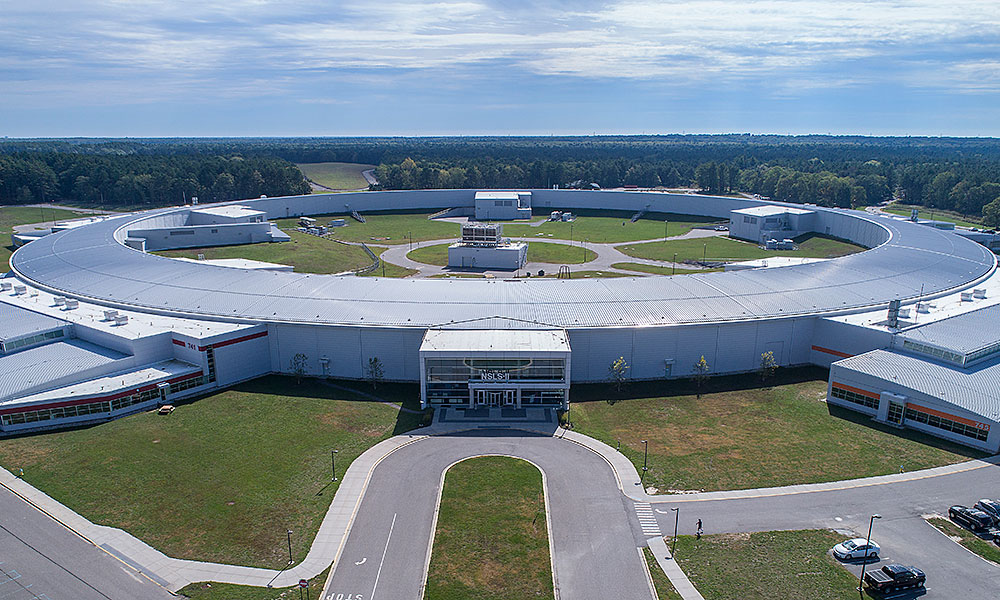World's X-ray Facilities Team up to Battle COVID-19
June 15, 2020
 enlarge
enlarge
Scientists used Brookhaven National Laboratory's National Synchrotron Light Source II (NSLS-II) for research on potential treatments of COVID-19.
The best and brightest light source facilities in the world are working together to help in the fight against the COVID-19 pandemic. Brookhaven National Laboratory’s own light source, the National Synchrotron Light Source II (NSLS-II), a U.S. Department of Energy (DOE) Office of Science User Facility, is among the many facilities tackling this challenge.
In April, leadership of the world’s x-ray science facilities, including NSLS-II Director John Hill, convened for a virtual summit. Below is the communique developed at this summit, outlining how these facilities will work together to share information about COVID-19. The NSLS-II continues to offer rapid access to the facility’s instrumentation for research on combating COVID-19.
“Science has been the solution to many problems in the past, and this will not be an exception. By coming together, pooling our resources, and sharing our growing knowledge about ways to fight this disease, we can make faster progress. At NSLS-II, we are all proud to be part of this international effort,” Hill said.
Read more on Brookhaven Lab’s work to fight the coronavirus.
The virtual summit and the plan for action
The COVID-19 pandemic is, more than ever, uniting scientists and the X-ray Science Facilities worldwide, in their sorrow for the loss of life and the suffering the virus has caused for the people around the world. They also express heartfelt admiration and lasting gratitude to all frontline health workers for their tireless dedication to treating the people impacted by the pandemic.
The international network of X-ray Science Facilities, composed of the X-ray Synchrotron Radiation and X-ray Free Electron Laser Facilities, is deeply engaged with overcoming the pandemic. The X-ray Science Facilities’ role is to create and implement scientific and technological research activities to effectively study, understand and contribute solutions to the COVID-19 pandemic, including new drugs, therapeutic strategies and medical equipment developments.
This engagement has already started worldwide, and many X-ray Science Facilities are carrying out research focused on the SARS-CoV-2 virus, and making available their instruments with rapid access and remote channels to scientists desiring to address specific COVID-19 research topics.
The X-ray Science Facilities gathered to align intents and strategies on “development of alliances between universities, industry and facilities” at their first SR9 Summit, which was held in Sendai, Japan in April 2019.
The X-ray Science Facilities, with the intent to further coordinate and strengthen their support of scientific research and solutions to the COVID-19 pandemic, assembled for a remote access video SR20 Summit on 23-24 April 2020. They shared their experience on facility activities in the recent weeks, and decided to develop a cooperative strategy across all facilities worldwide to work jointly to overcome the pandemic.
The X-ray Science Facilities adopted the following action plan:
- Share information and contribute to the coordination of efforts across all X-ray Science Facilities on scientific research addressing the COVID-19 pandemic
- Explore the establishment of a worldwide X-ray Science Facilities network including university and industrial users for a comprehensive mobilization of facilities
- Study the development of a shared IT system to accelerate the process of information distribution, favor global cooperation among facilities, and enable the most rapid and effective access for scientific projects across facilities
- Exchange experience on remote access and sample mail-in procedures by the user community to maintain and strengthen experimental activities without user travel.
- Coordinate efforts of the X-ray Science Facilities with those of other analytical facilities as, for example, those using neutrons, cryo-electron-microscopy, lasers and nuclear magnetic resonance
Delegates
- Prof. Dr. Hideo Ohno, President, ?TOHOKU University
- Dr. Chi-Chang Kao, Director, SLAC National Accelerator Laboratory
- Prof. Paul McIntyre, Director, SSRL
- Prof. Michael Dunne, Director, LCLS
- Dr. Stephen Streiffer, Director, Advanced Photon Source
- Dr. Stephen Kevan, Director, Advanced Light Source
- Dr. John Hill, Director, NSLS-Il
- Prof Joel Brock, Director, CHESS
- Prof. Andrew Peele, Director, ANSTO Australian Synchrotron
- Dr. Gwo-Hui Luo, Director, NSRRC
- Dr. Tetsuya Tshikawa, Director, RIKEN SPring-8 Center
- Dr. Tn Soo Ko, Director, Pohang Accelerator Laboratory
- Dr. Francesco Sette, Director General, ESRF
- Prof. Edgar Weckert, Reseach Director, DESY
- Prof. Robert Feidenhans’l, Managing Director, European XFEL
- Dr. Jean Daillant, Director, Soleil Laboratory
- Dr. Andrew Harrison, CEO, Diamond Light Source Limited
- Dr. Caterina Biscari, Director, ALBA
- Prof. Gabriel Aeppli, Head Photon Science Division, Paul Scherrer Institut, ETH and EPFL
- Dr. Ian McNulty, Director, Max IV
- Prof. Jan Lüning, Scientific Director, BESSY II, Helmholtz-Zentrum Berlin
- Dr. Claudio Masciovecchio, Director FERMI Free Electron Laser
Brookhaven National Laboratory is supported by the U.S. Department of Energy’s Office of Science. The Office of Science is the single largest supporter of basic research in the physical sciences in the United States and is working to address some of the most pressing challenges of our time. For more information, visit https://www.energy.gov/science/
Follow @BrookhavenLab on Twitter or find us on Facebook
2020-17274 | INT/EXT | Newsroom









